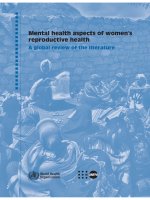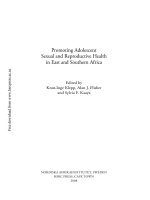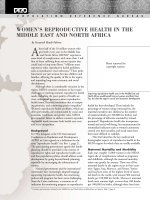WOMEN''''S REPRODUCTIVE HEALTH IN THE MIDDLE EAST AND NORTH AFRICA pptx
Bạn đang xem bản rút gọn của tài liệu. Xem và tải ngay bản đầy đủ của tài liệu tại đây (233.07 KB, 8 trang )
A
bout half of the 10 million women who
give birth every year in the Middle East
and North Africa (MENA)* experience
some kind of complication, with more than 1 mil-
lion of them suffering from serious injuries that
could lead to long-term illness.
1
Millions more
experience other reproductive health problems,
such as reproductive tract infections.
2
These prob-
lems harm not just women but also children and
families, affecting the quality of life in the region
and impeding long-term economic and social
development.
Although there is considerable variation in the
region, MENA countries continue to face major
challenges to meeting women’s reproductive health
needs, including the poor quality of health ser-
vices, widespread ignorance about reproductive
health issues, financial constraints due to compet-
ing priorities, and continuing gender inequality.
3
Women’s reproductive health problems, which are
often preventable, are compounded by social and
economic conditions and gender roles. MENA
governments’ failure to address women’s reproduc-
tive health needs increases both health care costs
and social inequalities.
Background
In 1994, delegates at the UN International
Conference on Population and Development
(ICPD) in Cairo agreed on a definition for the
term “reproductive health” (see Box 1, page 2).
The participating governments agreed that family
planning should be provided in the context of
reproductive rights and reproductive health care
and that population policies should address social
development by going beyond family planning,
especially by encouraging the advancement of
women.
National governments and the international
community have increasingly adopted language
supporting reproductive health, but reorienting
policies and programs has been more challenging.
Since the Cairo conference, a common set of
indicators for monitoring progress on reproductive
health has been developed. These include the
percentage of women using contraceptives, the
maternal mortality ratio (defined as the number
of maternal deaths per 100,000 live births), and
the percentage of deliveries attended by trained
personnel.
4
Reproductive health also incorporates
mental and social well-being, but measurements for
nonmedical indicators such as women’s autonomy,
control over their sexuality, and social status have
been more difficult to establish.
This brief describes the key medical and
demographic aspects of reproductive health in the
MENA region for which data are readily available.
Maternal Mortality and Morbidity
Each year, roughly 13,000 women in the MENA
region die of complications related to pregnancy
and childbirth, although the maternal mortality
ratios vary greatly by country. Three out of five
maternal deaths in the region occur in four coun-
tries: Egypt, Iraq, Morocco, and Yemen. Yemen
and Iraq have some of the highest levels of mater-
nal death in the world, with around 300 maternal
deaths per 100,000 live births. Morocco’s maternal
death ratio remains high, at more than 200 deaths
per 100,000 live births, although there have been
WOMEN’S REPRODUCTIVE HEALTH IN THE
MIDDLE EAST AND NORTH AFRICA
Improving reproductive health care in the Middle East and
North Africa would benefit not just women and their fami-
lies, but also the region’s social and economic development.
by Farzaneh Roudi-Fahimi
* Countries and territories included in the Middle East and North Africa as defined here are listed in Table 1 (page 4).
POPULATION REFERENCE BUREAU
Photo removed for
copyright reasons.
improvements in maternal health in the country
over the past 20 years. A recent survey of maternal
mortality in Egypt showed that the number of
women dying of maternal causes fell from 174
deaths per 100,000 live births in 1992 to 84
deaths per 100,000 live births in 2000.
5
Not surprisingly, the lowest maternal mortality
ratios in the MENA region are found in countries
with the highest levels of health expenditure per
capita and the smallest gender gaps in education.
6
Only Kuwait and the United Arab Emirates have
managed to reduce their maternal mortality ratios
to levels considered low by international standards
(not more than 5 maternal deaths per 100,000 live
births). Maternal mortality is fairly low in Oman,
Qatar, and Saudi Arabia, but ratios in all three
countries remain higher than those in countries
outside the region that have comparable per capita
incomes.
7
Maternal deaths are strongly associated with
the absence of good medical care before, during,
and after delivery. More than half of all maternal
deaths worldwide occur within 24 hours of deliv-
ery, mostly due to postpartum hemorrhage.
8
The
most effective way to prevent maternal deaths is to
have deliveries attended by skilled personnel who
can recognize and treat or refer any complications
that arise. (Skilled personnel include health profes-
sionals such as physicians, nurses, and midwives
but do not include traditional birth attendants
who have not been trained to perform emergency
life-saving medical interventions.) Since women
living in higher-income countries generally have
better access to health services, higher percentages
of their deliveries take place in health facilities
with skilled attendants, although there is often a
gap between rural and urban areas throughout the
region (see Figure 1).
Access to quality antenatal care and a good
referral system can also improve maternal health.
Although an increasing number of women in
MENA countries are seeking antenatal care, rates
in the region are still low: Less than 70 percent of
pregnant women have at least one antenatal check-
up, putting the region behind east Asia (excluding
China) and Latin America.
9
Even fewer women in
MENA countries receive multiple checkups. In
Tu rkey, for example, 67 percent of pregnant
women had at least one antenatal visit, but only 42
percent had at least four such visits.
10
While nearly all women in industrialized coun-
tries receive antenatal care, many pregnant women
in MENA countries seek antenatal care only when
they have a complaint. According to one study of
maternal health in Morocco, 50 percent of women
who had not sought care during their pregnancies
reported that they did not seek antenatal care
because they had no problems; another 22 percent
of those who did not seek care reported that such
services were not available to them; and another 10
percent said the services were too expensive.
11
Women in other countries, such as Yemen and
Algeria, also report difficulty accessing health facili-
ties as a reason for not seeking antenatal care.
The relatively low rates of antenatal care in
the region are due in part to the lack of public
awareness about the importance of medical care
during pregnancy. The widespread ignorance
about anemia provides a good example. Anemia
lowers women’s tolerance of blood loss and resis-
tance to infection, contributing to maternal illness
and death. Although anemia is common through-
out the MENA region (regardless of countries’
income levels), few anemic women recognize the
symptoms and seek treatment.
Cultural obstacles can also prevent women
from seeking health services. For example, many
women prefer to see female health care providers,
but few such providers are available in many parts
of the region. Often, pregnant women are not the
PRB MENA Policy Brief 2003
Box 1
Reproductive Health and Rights Defined in the Cairo
Programme of Action
Reproductive health is a state of complete physical, mental and social well-
being and not merely the absence of disease or infirmity, in all matters relat-
ing to the reproductive system and to its functions and processes. Reproduc-
tive health therefore implies that people are able to have a satisfying and safe
sex life and that they have the capability to reproduce and the freedom to
decide if, when and how often to do so. Implicit in this last condition are the
right of men and women to be informed and to have access to safe, effective,
affordable and acceptable methods of family planning of their choice, as well
as other methods of their choice for regulation of fertility which are not
against the law, and the right of access to appropriate health-care services that
will enable women to go safely through pregnancy and childbirth and provide
couples with the best chance of having a healthy infant.
SOURCE: United Nations, “Programme of Action of the International Conference on Population and
Development,” paragraph 7.2, accessed online at www.iisd.ca/linkages/Cairo/program/p07002.html,
on Dec. 9, 2002.
2
PRB MENA Policy Brief 2003
ones who decide whether to seek care, so educat-
ing husbands and other family members about
reproductive health issues is particularly impor-
tant. Reducing cultural, financial, and physical
obstacles to reproductive health care services is
necessary for improving maternal health.
Closing the gap between rural and urban
areas’ access to and use of reproductive health care
is a major challenge for MENA governments. The
rural-urban gap is particularly large in lower-
income countries in the region. In Egypt, for
example, only 42 percent of pregnant women in
rural areas received any antenatal checkups, com-
pared with 70 percent of those living in urban
areas; in Morocco, the rates are 56 percent and 88
percent, respectively.
12
Rates of postnatal care in MENA are even
lower than those of antenatal care. Postnatal care
is important for identifying and treating child-
birth-related injuries and illnesses, promoting
breastfeeding, and counseling couples about
appropriate family planning methods for spacing
births. Home visits by health personnel can help
reach women who have difficulty leaving the
home due to complications or to cultural beliefs
that women should stay home following child-
birth, but most practitioners in the MENA region
do not offer home visits.
Maternal morbidity, or nonfatal illness or injury
due to pregnancy and childbirth, is difficult to eval-
uate accurately in less developed countries, especial-
ly since women themselves may not recognize the
symptoms. Prevalence of low birth weight is some-
times used to assess maternal health. Low birth
weight is usually the result of the mother’s poor
health and nutritional status during pregnancy. In
Yemen, which has the region’s highest rate of low
birth weight, 26 percent of babies born alive weigh
less than 2.5 kilograms, the standard definition for
low birth weight. Saudi Arabia has the region’s low-
est rates of low birth weight: Only 3 percent of
babies born there weigh less than 2.5 kilograms.
13
Complications from unsafe abortions—those
that are self-induced or carried out by unskilled
providers—are also a major cause of maternal death
and disability. Abortion is a relatively safe proce-
dure when performed by qualified doctors using
correct techniques in sanitary conditions. But in
countries where abortion is illegal or safe abortion
services are not available, women with unwanted
pregnancies may seek clandestine abor-
tion services or drugs and other means
of inducing abortion. Unsafe abortion
may lead to serious complications,
such as infection and injuries, that
require emergency care. In the devel-
oping world, 16 percent of all mater-
nal deaths are attributed to unsafe
abortions, whether legal or illegal.
14
It
is estimated that over 1 million unsafe
abortions are performed in MENA
countries each year.
15
Data on abortions in MENA
countries are rarely collected and ana-
lyzed, although more data are available
in countries where abortion is legal. In
Tu rkey, where abortion is legal, abor-
tions are available at government hos-
pitals for a nominal fee and at private
clinics for a larger fee. The results of
Tu rkey’s 1998 Demographic and
Health Survey reveal that 23 percent of all preg-
nancies that occurred in the five years prior to the
survey were terminated by abortion. In two-thirds
of those cases, the women reported that they had
been practicing a family planning method when
they became pregnant (see Figure 2).
16
35
70
95
75
97
96
74
19
95
83
61
48
97
78
80
60
31
11
96
88
Egypt Iran Jordan Libya Morocco Saudi
Arabia
Syria Tunisia Turkey Yemen
Percent of urban deliveries Percent of rural deliveries
F igure 1
Share of Rural and Urban Deliveries Taking Place in
Health Facilities
NOTE: Data are provided for the following years: Morocco and Libya, 1995; Saudi Arabia, 1996;
Yemen, 1997; Turkey, 1998; Egypt and Iran, 2000; Syria and Tunisia, 2001; and Jordan, 2002.
SOURCE: ORC Macro, Demographic and Health Surveys for Egypt, Jordan, Morocco, Turkey,
and Yemen; United Nations Population Fund et al., Demographic and Health Survey of Iran (2002).
Data for Libya, Syria, and Tunisia are taken from the Pan-Arab Family Health Survey. Data for
Saudi Arabia are from the Arab Gulf Cooperation Council, Gulf Family Health Survey.
22%
Modern
method
33%
No
method
45%
Traditional
method
F igure 2
Abortions in Turkey by
Contraceptive Method
Used in Month Before
Pregnancy
SOURCE: ORC Macro, Tu rkey
Demographic and Health Survey, 1998:
table 5.5.
3
PRB MENA Policy Brief 2003
4
Fertility and Family Planning
MENA’s total fertility rate (TFR) has declined from
an average of 7.0 children per woman in 1960 to
3.3 children in 2002—still well above the world
average of 2.8 children per woman. Although the
region’s overall TFR has declined, fertility rates in
some MENA countries remain above 5.0 children
per woman (see Table 1).
A growing number of MENA countries are
including family planning programs in their nation-
al development plans, although rates of family plan-
ning are still uneven. In Iran, which reintroduced
family planning in the late 1980s, 74 percent of
married women practice family planning, the high-
est rate in the region.
17
In Yemen, which adopted
its national population policy in 1991, less than 25
percent of married women practice family plan-
ning, the lowest level in the region.
18
Use of family planning contributes to mater-
nal and infant health and survival by reducing the
number of unplanned pregnancies. Reducing the
number of deliveries and increasing the time
between births help save the lives of both women
and their infants. International data suggest that
siblings born three to five years apart are about
2.5 times more likely to survive to age 5 than sib-
lings born less than two years apart.
19
In MENA
countries, many brothers and sisters are born close
together: 44 percent of babies in Jordan are born
less than two years after their older sibling.
20
On average, about 60 percent of married
women in MENA countries practice family plan-
ning.
21
Still, surveys throughout the region show
that there is a large unmet need for family plan-
ning, as measured by the number of women who
report that they would prefer to avoid a pregnancy
a
Palestine inclues the Arab population of the West Bank and Gaza.
— = data not available.
NOTE: GNI PPP per capita is gross national income in purchasing power parity (PPP) divided by midyear population. GNI PPP refers to gross national income converted to “inter-
national” dollars using a purchasing power parity conversion factor. International dollars indicate the amount of goods and services one could buy in the United States with a given
amount of money. Data are from the World Bank, 2002 World Development Indicators.
SOURCES: United Nations, World Population Projections: The 2000 Revision (2001); United Nations, World Population Monitoring 2002—Reproductive Rights and Reproductive Health:
Selected Aspects (2002); League of Arab States, Pan-Arab Project for Child Development: Arab Mother and Child Health Surveys (Algeria 1992, Lebanon and Libya 1995) and Pan-Arab
Women 15–49 Years Old
Number in
2002
(thousands)
Number in
2015
(thousands)
Percent
Increase
2002–2015
Percent of Women
Who Are Married
15–19
Years Old
20–24
Years Old
Percent of Married Women 15–49
Years Old Using Contraceptives
Any Method
Total
Urban Rural
Total
Fertility
Rate
T able 1
Selected Reproductive Health Indicators in the Middle East and North Africa
Middle East and North Africa 100,046 129,944 30 12 47 3.3 59 64 52
Algeria 8,438 10,553 25 4 30 2.8 64 67 62
Bahrain 162 186 15 3 30 2.5 62 — —
Egypt 18,157 22,862 26 12 53 3.5 56 61 52
Iran 18,789 24,242 29 16 — 2.0 74 77 67
Iraq 5,842 8,423 44 — — 5.3 — — —
Jordan 1,251 1,807 44 8 38 3.6 56 57 50
Kuwait 485 658 36 5 40 4.2 52 — —
Lebanon 1,022 1,176 15 — — 2.4 63 — —
Libya 1,479 1,888 28 1 12 3.9 45 48 36
Morocco 8,300 10,207 23 10 37 3.3 58 — —
Oman 584 939 61 15 58 6.1 24 28 16
Palestine
a
748 1,228 64 24 62 5.9 51 — —
Qatar 114 136 19 4 31 3.9 43 — —
Saudi Arabia 4,638 7,465 61 7 39 5.7 32 37 21
Syria 4,345 6,131 41 11 42 3.8 47 54 38
Tunisia 2,728 3,058 12 1 14 2.1 63 65 58
Turkey 18,264 21,276 16 15 59 2.5 64 67 58
UAE 497 616 24 8 40 3.5 28 30 22
Yemen 4,202 7,094 69 26 70 7.2 21 36 16
PRB MENA Policy Brief 2003
but who are not using contraception (see Figure 3,
page 6). A recent pregnancy, fear of contraceptives’
side effects, and opposition from husbands and rel-
atives are issues commonly cited by women with
unmet need. Some women report having tried to
use contraceptives in the past but finding it diffi-
cult; women who are not satisfied with a particular
method may stop using contraception entirely.
Some family planning providers also fail to meet
women’s reproductive health needs.
Increasing access to high-quality family plan-
ning information and services can reduce the num-
ber of unintended pregnancies. One study has
shown that if no women experienced contraceptive
failure or stopped using a method, Egypt and
Jordan’s total fertility rates would drop to 2.0
births per woman, Morocco’s to 2.4, and Turkey’s
to 1.5.
22
Providing a range of contraceptive meth-
ods to meet women’s changing needs as they go
through the life cycle is important; for example,
mothers with infants need contraceptive methods
that do not interfere with breastfeeding. It is also
important that access and services be provided to
hard-to-reach populations, such as women in rural
areas and those with little or no education.
Approximately 10 percent of couples world-
wide experience problems conceiving children.
23
Although there is nothing to suggest that infertili-
ty is more prevalent in MENA countries than else-
where, the issue is especially important in the
region. Cultural values in the region praise moth-
erhood and stigmatize childless women, pressuring
women to start families soon after they marry.
Those who do not become pregnant usually seek
medical treatment, often at great expense. Assisted
reproductive technologies are increasingly becom-
Project for Family Health (Syria and Tunisia 2001); Council of Health Ministers of Gulf Cooperation Council States, Gulf Family Health Surveys (Bahrain 1995, Kuwait 1996, Oman
1995, Qatar 1998, Saudi Arabia 1996, UAE 1995); POPIN Population Information Network, Western Asia, “Country Data and Population Pyramids” (www.escwa.org.lb/popin/
indicators/main.html, accessed Aug. 14, 2002); ORC Macro, Demographic and Health Surveys (Egypt 2000, Jordan 1997 and 2002, Morocco 1995, Turkey 1998, Yemen 1997);
Palestinian Central Bureau of Statistics, “Selected Statistics” (www.pcbs.org/inside/selcts.htm, accessed July 17, 2002); United Nations Children’s Fund (UNICEF), Multiple Indicator
Cluster Surveys—National Reports (www.childinfo.org/MICS2/natlMICSrepz/MICSnatrep.htm, accessed Aug. 20, 2002), The State of the World’s Children 2003
(www.unicef.org/sowc03/, accessed Jan. 2, 2003), and UNICEF Global Database (www.childinfo.org, accessed Jan. 2, 2003); Ministry of Health and Population, National Maternal
Mortality Study, Egypt 2000 (2001); United Nations Population Fund et al., Simaie Jameeat va Salamat dar Jomhorie Eslamie Iran, Mehrmah 1379 (2000 DHS report in Farsi); and
World Bank, 2002 World Development Indicators.
Percent of Married Women 15–49
Years Old Using Contraceptives
Modern Methods
Total Urban Rural
Percent of Births
Attended by
Skilled Personnel
Total Urban
Rural
GNI PPP per
Capita, 2000
(US$)
Percent of
Births With
Low Birth
Weight
Maternal
Deaths per
100,000
Live Births
Percent of All Deliveries
Conducted in Health
Facilities
Total Urban
Rural
45 47 41 70 88 54 64 81 45 130 11 — Middle East and North Africa
50 53 48 78 88 69 76 84 68 140 7 5,040 Algeria
31 — — 98 — — 98 — — 46 10 — Bahrain
54 59 50 61 81 48 48 70 35 84 10 3,670 Egypt
56 55 57 90 96 79 88 95 75 37 7 5,910 Iran
———54— — ——— 290 23 — Iraq
39 40 31 98 99 97 97 97 96 41 10 3,950 Jordan
39 — — 98 — — 98 — — 5 7 18,690 Kuwait
40 — — 89 94 84 88 92 84 100 6 4,550 Lebanon
26 28 19 94 97 89 94 96 88 75 7 — Libya
49 — — 40 80 20 37 74 19 230 9 3,450 Morocco
18 22 12 91 93 88 89 91 85 14 8 — Oman
37 — — 97 — — — — — — 9 — Palestine
a
32 — — 98 — — 98 — — 10 10 — Qatar
29 33 19 91 95 84 91 95 83 23 3 11,390 Saudi Arabia
35 42 28 89 96 83 55 61 48 65 6 3,340 Syria
53 53 54 91 98 79 90 97 78 70 5 6,070 Tunisia
38 41 31 81 88 69 73 80 60 130 15 7,030 Turkey
24 25 20 99 100 99 99 99 99 3 — — UAE
10 21 6 22 47 14 16 31 11 350 26 770 Yemen
5
ing available in the region, mainly through private
providers, but the degree of reliability varies.
Governments in the region need to establish stan-
dard protocols for infertility treatment, both to
ensure the quality of care and to contain costs.
Sexually Transmitted Infections and
Reproductive Tract Infections
More than 12 million people in the MENA region
suffer from sexually transmitted infections (STIs)
such as syphilis, gonorrhea, and chlamydia.
24
Although the prevalence of STIs in MENA coun-
tries is relatively low, reflecting cultural condemna-
tion of sexual relationships outside of marriage, it
is increasing rapidly. In addition, STIs are signifi-
cantly underreported in the region, as they are else-
where. For the most part, MENA countries are not
equipped with effective systems for detecting and
reporting these infections.
25
Despite the cultural values condemning sex
outside of marriage, high-risk sexual behavior,
such as sex with multiple partners, does occur in
MENA countries. The public is generally unaware
of the extent of high-risk behaviors and of mea-
sures for preventing infections. Men who are away
from their families, such as migrant laborers, are
the most likely to put themselves at risk. Infected
men can then transmit STIs to their wives, who
become victims of their husbands’ ignorance. A
study in Jordan showed that between 3 percent
and 7 percent of men who participated in the sur-
vey had had sexual contact outside of marriage.
26
The conservative social mores that discourage
extramarital sex also discourage open discussion of
sexuality, condoms, STIs, and HIV/AIDS. But
open, frank dialogue is key to addressing STIs and
other reproductive health needs and should be ini-
tiated in order to save lives throughout the region.
HIV/AIDS, for example, is still relatively rare in
MENA countries, but it is becoming more preva-
lent. An estimated 70,000 adults and children in
MENA countries were living with HIV/AIDS at
the end of 2001.
27
Many women in MENA countries also suffer
from other reproductive tract infections (RTIs)
caused by lack of clean water for bathing and
unclean practices during delivery or abortion.
RTIs can cause persistent pain and discomfort,
diminishing women’s productivity and quality of
life. Severe RTIs may lead to infertility or even
death, especially if left untreated. Many women
do not realize they have a treatable RTI, because
they have been taught to accept the symptoms as
part of being a woman. More than half of the
women who participated in a small community-
based study in rural Egypt reported having symp-
toms indicating RTIs.
28
Women’s low social status
plays an important part in keeping women’s suf-
fering from being recognized and addressed.
A recent pilot study of another rural commu-
nity in Egypt found that reproductive health
problems were hidden and women rarely, if ever,
sought care for such problems. Although half the
women who received a cervical biopsy were found
to suffer from female genital schistosomiasis, the
women considered the problems “normal” and
rarely discussed them with their husbands or
female relatives. The study found that interven-
tions designed to improve women’s reproductive
health must involve men, since men are often key
decisionmakers about women’s health care.
29
Adolescent Reproductive Health
Young people between the ages of 10 and 24 make
up one-third of the region’s population, or about
125 million people. While adolescence is generally
a healthy period of life, young people may be
exposed to the risks associated with sexual activity,
including STIs, unintended pregnancies, and
complications from pregnancy and childbirth.
Social and health care services in MENA countries
are ill-equipped to address young people’s repro-
PRB MENA Policy Brief 2003
6
11
14
16
10
39
Egypt
(2000)
Jordan
(1997)
Morocco
(1995)
Turkey
(1998)
Yemen
(1997)
Percent of married women
F igure 3
Married Women Who Would Prefer to Avoid a
Pregnancy But Who Are Not Using Contraception
SOURCES: ORC Macro, Demographic and Health Surveys.
ductive health care needs, although some coun-
tries in the region are now trying to reach out to
youth. For example, Iran requires that prospective
brides and grooms take a class on reproductive
health and family planning, and all university stu-
dents in Iran are required to take a course on
population and family planning.
High teenage fertility, the result of the high
incidence of early marriage, is a reproductive
health concern in a number of MENA countries.
Although the average age at first marriage has
increased overall, it is still common for women in
some social groups to marry before age 20. In the
MENA region, around 4 million young women
under age 20 are married. Women who become
pregnant while their bodies are still developing are
at a greater risk of complications that threaten
themselves and their babies.
Female genital cutting (FGC), the practice of
removing all or part of young girls’ external geni-
talia, is a major reproductive health issue in Egypt
and Yemen and, to a lesser extent, in the coastal
areas of the Arabian peninsula. FGC is almost
universal in Egypt, where 97 percent of women of
reproductive age have undergone the procedure;
Yemen has the second-highest prevalence, at 23
percent.
30
FGC can lead to health complications
such as infection, severe bleeding, and obstetric
complications, as well as psychological trauma.
31
In addition, when performed on young girls and
nonconsenting women, FGC violates a number of
recognized human rights.
The Need for Action
Governments can take a number of steps to
improve reproductive health within their coun-
tries. These steps can, in turn, improve quality of
life throughout the region.
32
■ Raise awareness of health problems and provide
information that people can use to change their
behaviors. Target audiences for such efforts
include women, husbands, elders, community
leaders, and policymakers.
■ Focus on priority issues, such as high fertility
and maternal mortality.
■ Target the underprivileged, especially the poor
and those living in rural areas, and decrease dis-
parities within countries.
■ Improve quality of care by establishing standard
protocols, setting up systems for monitoring and
regulating quality, training and deploying skilled
health professionals, and securing essential equip-
ment and drugs. It is also important to improve
managerial capacity at all levels.
■ Develop sustainable financing mechanisms, pos-
sibly through private-sector involvement and com-
munity financing, to ensure that women have
access to essential health services.
■ Promote women’s participation in decisionmak-
ing and the overall development process.
Conclusions
Investing in women’s reproductive health not only
advances human rights and improves the health
and well-being of individual women and their
families, but it also benefits societies and national
economies. According to the United Nations
Population Fund, countries that have made social
investments in health, family planning, and edu-
cation have slower population growth and faster
economic growth than countries that have not
made such investments. While there have been
significant improvements in women’s reproductive
health in many parts of the MENA region, further
changes are crucial to achieving social equity and
economic development in the region.
Addressing women’s reproductive health needs,
particularly in conservative societies, requires strong
commitments on the part of governments as well as
nongovernmental health and human rights advo-
cates. Although reproductive health issues are sensi-
tive topics for many people, it is important that
7
PRB MENA Policy Brief 2003
Since they are often key decisionmakers about women’s health care in
MENA countries, it is important to educate men about reproductive
health issues.
Photo removed for
copyright reasons.
culturally appropriate discussions of public policy be
initiated. Failure to pay attention to and invest in
improving reproductive health today will only result
in greater health and social costs in the future.
References
1
Christopher Murray and Alan Lopez, eds., Health
Dimensions of Sex and Reproduction. Vol. 3, Global Burden of
Disease. Boston, MA: Harvard University Press, 1998.
2
Atsuko Aoyama, Reproductive Health in the Middle East and
North Africa: Well-Being for All (Washington, DC: World
Bank, 2001): 27.
3
Aoyama, Reproductive Health in the Middle East and North
Africa: xxi.
4
United Nations, “ICPD and ICPD+5,” accessed online at
www.unfpa.org/icpd/, on May 21, 2002.
5
Directorate of Maternal and Child Health Care, National
Maternal Mortality Study: Egypt 2000 (Cairo: Directorate of
Maternal and Child Health Care, Ministry of Health and
Population, 2001).
6
Aoyama, Reproductive Health in the Middle East and North
Africa: figures 26, 30, and 33.
7
United Nations Development Programme (UNDP), Arab
Human Development Report 2002: Creating Opportunities for
Future Generations (New York: UNDP, 2002).
8
X. F. Li et al., “The Postpartum Period: The Key to
Maternal Mortality,” International Journal of Gynecology and
Obstetrics 54, no. 1 (1996): 1-10.
9
United Nations Children’s Fund (UNICEF), “Antenatal
Care by Region,” accessed online at www.childinfo.org/eddb/
antenatal/grpreg.htm, on Nov. 1, 2002.
10
ORC Macro, Turkey Demographic Health Survey, 1998
(Calverton, MD: ORC Macro, 1999): table 9.2.
11
USAID/Morocco and Ministry of Health, Morocco: 30
Years of Collaboration Between USAID and the Ministry of
Health: A Retrospective Analysis—Safe Motherhood (New
Orleans: Tulane University School of Public Health and
Tr opical Medicine ): 21.
12
USAID/Morocco and Ministry of Health, Morocco: 30
Years of Collaboration Between USAID and the Ministry of
Health: figure 4; and ORC Macro, Egypt Demographic and
Health Survey, 2000 (Calverton, MD: ORC Macro, 2001):
table 11.5.
13
UNICEF, State of the World’s Children 2003, accessed
online at www.unicef.org/sowc03/, on Dec. 31, 2002.
14
Lori Ashford, “Hidden Suffering: Disabilities From
Pregnancy and Childbirth in Less Developed Countries”
(Washington, DC: Population Reference Bureau, 2002).
15
Elisabeth Ahman and Igbal Shah, “Unsafe Abortion:
Worldwide Estimates for 2000,” Reproductive Health Matters
10, no. 19 (2002): 13-17.
16
ORC Macro, Turkey Demographic and Health Survey, 1998
(Calverton, MD: ORC Macro, 1998): tables 5.3 and 5.5.
17
Farzaneh Roudi-Fahimi, “Iran’s Family Planning Program:
Responding to a Nation’s Needs” (Washington, DC:
Population Reference Bureau, 2002).
18
ORC Macro, Yemen Demographic and Health Survey, 1997
(Calverton, MD: ORC Macro, 1998).
19
John Hopkins University Center for Communication
Programs, “Birth Spacing: Three to Five Saves Lives,”
accessed online at www.jhuccp.org/pr/l13edsum.shtml, on
Nov. 21, 2002.
20
ORC Macro, Jordan Population and Family Health Survey,
1997 (Calverton, MD: ORC Macro, 1998): table 3.7.
21
Carl Haub and Britt Herstad, Family Planning Worldwide:
2002 Data Sheet (Washington, DC: Population Reference
Bureau, 2002).
22
Ann K. Blank et al., “Monitoring Contraceptive
Continuation: Links to Fertility Outcomes and Quality of
Care,” Studies in Family Planning 33, no. 2 (2002): 127-40.
23
Aoyama, Reproductive Health in the Middle East and North
Africa: 76.
24
Aoyama, Reproductive Health in the Middle East and North
Africa: 57.
25
Aoyama, Reproductive Health in the Middle East and North
Africa: 57.
26
Aoyama, Reproductive Health in the Middle East and North
Africa: 61.
27
United Nations Programme on HIV/AIDS (UNAIDS),
Report on the Global HIV/AIDS Epidemic (Geneva: UNAIDS,
2002).
28
Huda Zurayk et al., “Rethinking Family Planning Policy in
Light of Reproductive Health Research,” Policy Series in
Reproductive Health 1 (Cairo: Population Council Regional
Office for West Asia and North Africa, 1994): 5.
29
Maha Talaat, Impact of Schistosomiasis on Reproductive
Health: Pilot Study (Cairo: Community and Social Medicine
Department, Theodor Bilharz Research Institute, 2001).
30
Liz Creel, Abandoning Female Genital Cutting: Prevalence,
Attitudes, and Efforts to End the Practice (Washington, DC:
Population Reference Bureau, 2001): figure 2.
31
Creel, Abandoning Female Genital Cutting.
32
Aoyama, Reproductive Health in the Middle East and North
Africa: xxii.
Acknowledgments
Farzaneh (Nazy) Roudi-Fahimi adapted this brief in part
from the analysis and findings of a study conducted by Dr.
Atsuko Aoyama of the Nagoya University School of Medicine
in Japan. Dr. Aoyama is a former health specialist at the
World Bank in Washington, DC. Thanks are due to the fol-
lowing people, who reviewed different drafts of this report:
Atsuko Aoyama, Lori Ashford, Maha El-Adawy, Karima
Khalil, Elizabeth Ransom, Hoda Rashad, Nancy Yinger, and
Huda Zurayk. Haruna Kashiwase helped compile the data.
This work has been funded by the Ford Foundation.
About PRB
The Population Reference Bureau is the leader in providing
timely and objective information on U.S. and international
population trends and their implications.
© February 2003, Population Reference Bureau
POPULATION REFERENCE BUREAU
1875 Connecticut Ave., NW, Suite 520, Washington, DC 20009 USA
Tel.: 202-483-1100
■
Fax: 202-328-3937
■
E-mail:
Website: www.prb.org
PRINTED WITH
SOY INK
TM









